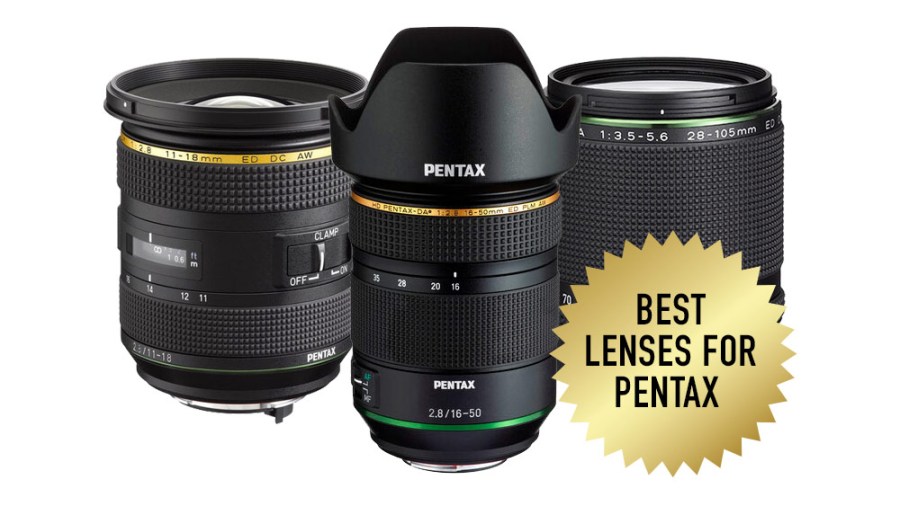Trying to work out what are the best Pentax lenses for your APS-C or full-frame DSLR? Tim Coleman picks out some greats to suit all budgets.
Welcome to our exhaustive guide to the best Pentax lenses you can buy. Unlike its rivals, Pentax is very much sticking with the DSLR, rather than moving into mirrorless, so it’s a good choice if you are also happy to continue using mirrored technology, or already have some Pentax lenses.
Pentax is certainly a company with a strong tradition. The Pentax K-mount has been going strong since 1976, when it was introduced for the legendary Pentax K film cameras. If you like rugged, weatherproof cameras, big, bright optical viewfinders and tactile ergonomics, Pentax kit is for you. Our team of reviewers have regularly given high scores to Pentax lenses for being sharp, well-engineered and ultra reliable – and we’ve picked out the cream of the crop for this guide.
We can’t sensibly include all the excellent lenses, so for this round-up, APS-C and full-frame lenses are grouped together by focal length; wide, standard, telephoto and super zoom.
Within these categories we include third-party options. We also highlight what genres they are particularly suited to, including the likes of macro photography and portraits.
If you’re still building your Pentax setup from the ground up, check out our unmissable guide to the best Pentax DSLRs. Otherwise, read on as we count off the best Pentax lenses you can buy today.
The best Pentax lenses for your DSLR: our quick list
Here’s a quick glance at the best Pentax lenses featured in this article:
- Best APS-C wide-angle zoom: HD Pentax-DA 11-18mm F2.8 ED DC AW
- Best full-frame, wide-angle zoom: HD Pentax-FA 15-30mm F2.8 ED SDM WR
- Best APS-C portrait lens: smc Pentax-DA* 55mm F1.4 SDM
- Best APS-C standard zoom: HD Pentax-DA* 16-50mm F2.8 ED PLM AW
- Best full-frame portrait lens: HD Pentax-FA 77mm f/1.8 Limited
- Best budget Pentax lens: smc Pentax-DA 35mm F2.4 AL
- Best compact Pentax lens: HD Pentax-DA 40mm F2.8 Limited
- Best APC-C telephoto zoom: smc Pentax-DA* 50-135mm F2.8 ED [IF] SDM
- Best Pentax macro lens: Pentax-D FA 100mm F2.8 Macro WR
- Best lens for wildlife: smc Pentax-DA* 300mm F4 ED [IF] SDM
- Best zoom lens for sports: HD Pentax-D FA 150-450mm F4.5-5.6 ED DC AW
- Best third-party portrait lens: Laowa 105mm f/2 (T3.2) STF
- Best third-party super-zoom: Sigma 18-300mm F3.5-6.3 DC Macro OS HSM
- Best full-frame travel lens: HD Pentax D FA 28-105mm f/3.5-5.6 ED DC WR
Best APS-C wide-angle zoom: HD Pentax-DA* 11-18mm F2.8 ED DC AW

At a glance:
- Aperture range f/2.8 to f/22
- Weighs 704g
- 17.5-27.5mm equivalent focal length
- 82mm Filter diameter
- In production
- Price: $1396 / £1199
Like many manufacturers, Pentax offers a trinity of f/2.8 zoom lenses aiming to give professionals and enthusiasts everything they could need. The 11-18mm is the widest of the three, though bear in mind that it’s an APS-C lens, so actually covers an equivalent focal range of 17.5-27.5mm focal length. Professional-grade, with super-sharp optics and HD lens coatings, it’s designed for all weathers and is ideal for landscape photography. The construction consists of 16 elements in 11 groups, including ED (extra low dispersion) elements to ensure minimal distortion.
One of the main advantages of an APS-C system compared to full-frame is that the cameras are lighter, and a good lens will reflect that. As such, the HD Pentax-DA* 11-18mm F2.8 ED DC AW weighs about half of its full-frame equivalent, making it a good choice for those who want a portable setup.
If you can live without the bright f/2.8 maximum aperture, then the Pentax DA 12-24mm F4 ED AL [IF] is a slightly more cost-effective and compact wide-angle zoom lens with a little further reach.
Pros:
- Nice and lightweight
- Sharp even wide open
Cons:
- APS-C only
Best full-frame wide-angle zoom: HD Pentax-D FA 15-30mm F2.8 ED SDM WR
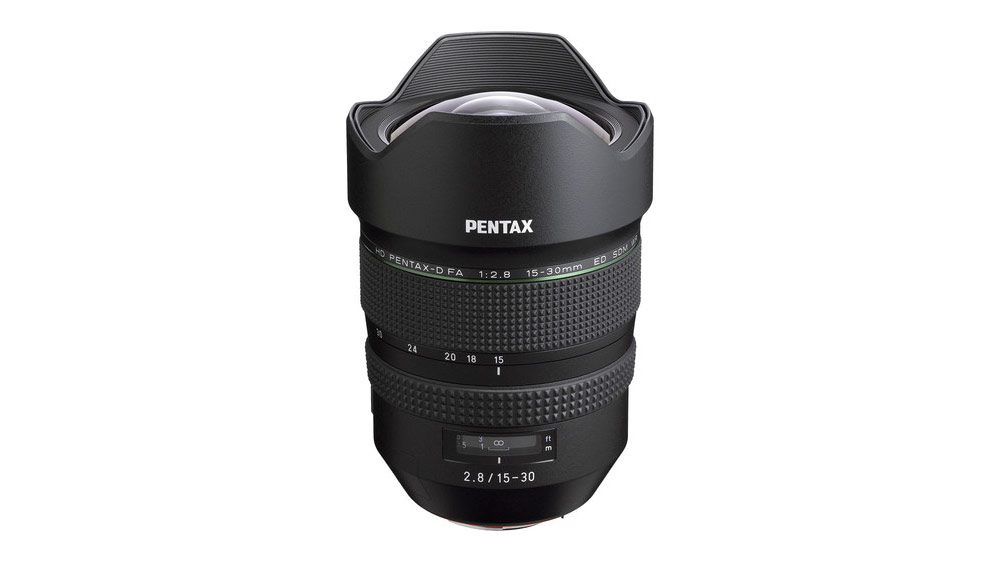
At a glance:
- Aperture range f/2.8 to f/22
- Weighs 1040g
- 23-45mm in APS-C crop mode
- No filter thread
- Not in production
- Price: $1446 / £1626
You’re not exactly spoilt for choice with Pentax full-frame wide-angle lenses. However, the Pentax 15-30mm F2.8, which was launched around the same time as the Pentax K-1 in 2016, is a fine choice.
It’s a reassuringly bulky lens at just over 1kg and, being weather resistant, is a solid pairing with a tough camera like the Pentax K1 or its replacement the K-1 II. This pairing is probably the best bet for astrophotographers because APS-C equivalents don’t go quite as wide – though the manual focus Laowa 12mm f/2.8 Zero-D is an excellent full-frame alternative.
Benefitting from a lens construction of 18 elements in 13 groups, this lens is sharp from centre to edges even at the maximum f/2.8 aperture that is available throughout the entire zoom range. What might initially cause confusion to Pentax shooters, especially those that manual focus, is that the 15-30mm lens focuses in the opposite direction to every other Pentax lens.
Pros:
- Excellent sharpness, even wide open
- Tough, solid build
Cons:
- May be too heavy for some
- Focus ring direction is reversed, for some reason
Best APS-C portrait lens: smc Pentax-DA* 55mm F1.4 SDM
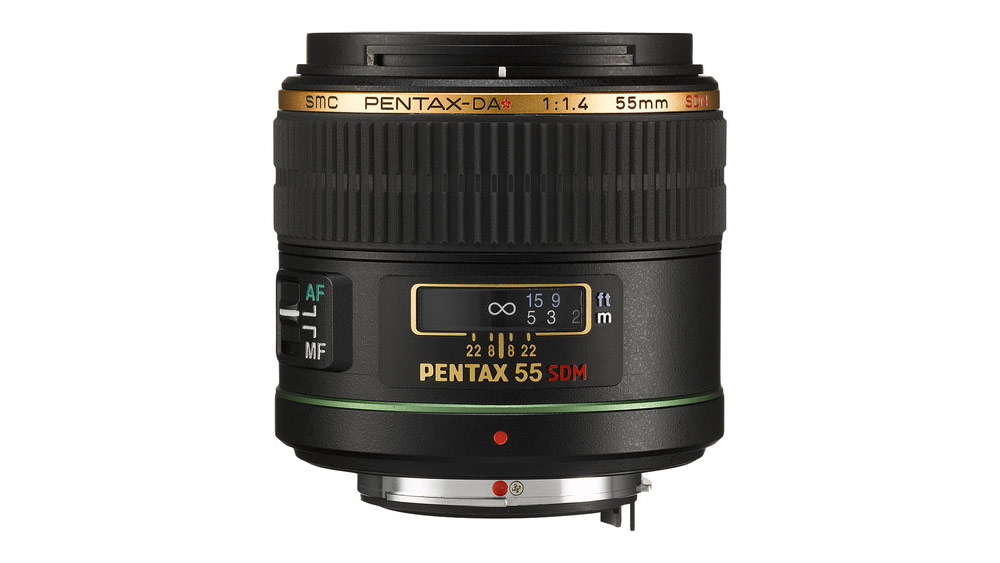
At a glance:
- 84.5mm equivalent focal length
- Weighs 375g
- Quick-Shift focus
- 58mm filter diameter
- In production
- Price: $646 / £599
Recreating the classic 85mm focal length associated with portraiture, the smc Pentax-DA* 55mm F1.4 SDM is an excellent choice particularly for those with an APS-C camera like the K-3 III, K-5 II or K-70. This medium telephoto lens offers a flattering perspective and bright f/1.4 maximum aperture with what Pentax claims is a round iris diaphragm up to f/2.8. In short, it’s a buttery-smooth-bokeh-beauty.
Elsewhere, there’s everything that we would expect of a Pentax * lens; an Aero Bright coating that reduces flare, weather-sealing to protect from water and dust ingress, while Quick-Shift focus comes in handy when creating such shallow depth of field portraits and you need to manually override autofocus to tweak focus exactly where you want it. This is portraiture at the next level.
Pros:
- Excels at portraiture
- Useful Quick-Shift focusing
Cons:
- Relatively pricey for Pentax
Best APS-C standard zoom: HD Pentax-DA* 16-50mm F2.8 ED PLM AW
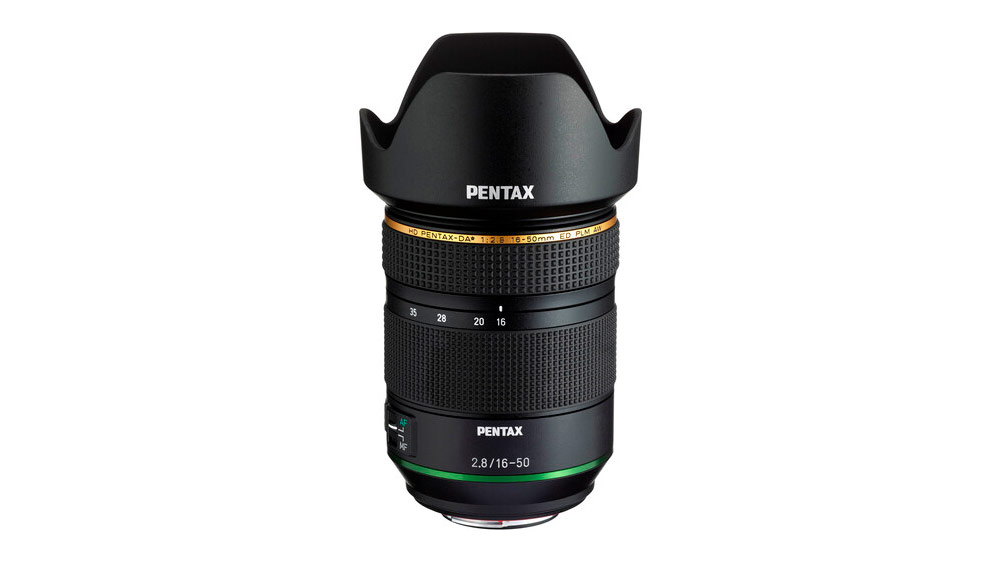
At a glance:
- 24.5-76.5mm equivalent focal length
- Weighs 712g
- Weather-resistant
- 77mm filter diameter
- In production
- Price: $1296 / £1349
The HD Pentax-DA* 16-50mm F2.8 ED PLM AW is your classic 24-70mm f/2.8 lens but for APS-C format cameras such as the Pentax K-3 III. If you’re cutting your teeth as a photographer, and limited to one lens only, it’s arguably the most versatile lens around, being popular with events, wedding, portrait and landscape photographers. Pentax also offers a full-frame equivalent for K-1 II shooters, the HD Pentax-D FA 24-70mm F2.8 ED SDM WR.
Technically a 24.5-76.5mm lens, this updated classic lens wearing the Pentax DA* badge boasts a 2x faster and quieter ‘PLM’ autofocus motor compared to the classic version, plus Pentax’s ‘AW’ dust and weather-resistant build and an array of aspherical (AL) and Extra low Dispersion (ED) lens elements for top drawer image quality. It’s a little pricey but can be found for way less than that RRP.
Pros:
- Useful, do-it-all focal range
- Fast, reliable autofocus
- Sophisticated optical construction
Cons:
- On the larger side
Best full-frame portrait lens: HD Pentax-FA 77mm f/1.8 Limited
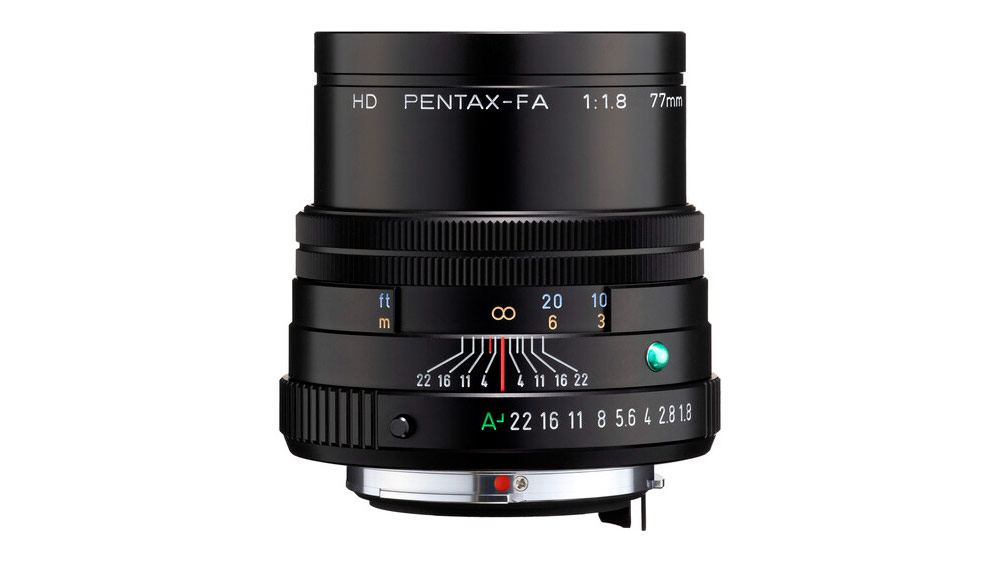
At a glance:
- Aperture range f/1.8 to f/22
- Weighs 270g
- Weather-resistant
- 49mm filter diameter
- Not in production
- Price: $696 / £729
We could have gone for a number of excellent full-frame K-mount lenses for portraiture, including the HD Pentax-D FA* 50mm F1.4 SDM AW or the HD Pentax-D FA* 85mm F1.4 ED SDM AW, but landed on the charming HD Pentax-FA 77mm f/1.8 limited. And no, that’s not a typo – this is the focal length and not the filter diameter.
The 77mm f/1.8 is part of a trio of ‘limited’ lenses updating FA legacy Pentax lenses more than 20-years old that also includes the 31mm f/1.8 and 43mm f/1.9.
In this updated version, handling is largely the same which is a good thing. This is a compact all-metal lens (though sadly it’s not officially weather-sealed) with aperture ring and focus distance scale and a clever retractable lens hood. Autofocus is possible via the camera body, though Quick Shift focus is missing, so you can’t manually override focus when in auto. Shame. Overall, the experience with this lens is better when manually focusing. What’s also new is the HD and SP coatings that reduce flare in bright light and protect that front lens element, plus the aperture blades are rounded so you get some gorgeous bokeh.
Pros:
- Rounded aperture blades
- High-end element coatings
Cons:
- Not officially weather sealed
- No Quick Shift focus
Best budget Pentax lens: smc Pentax-DA 35mm F2.4 AL
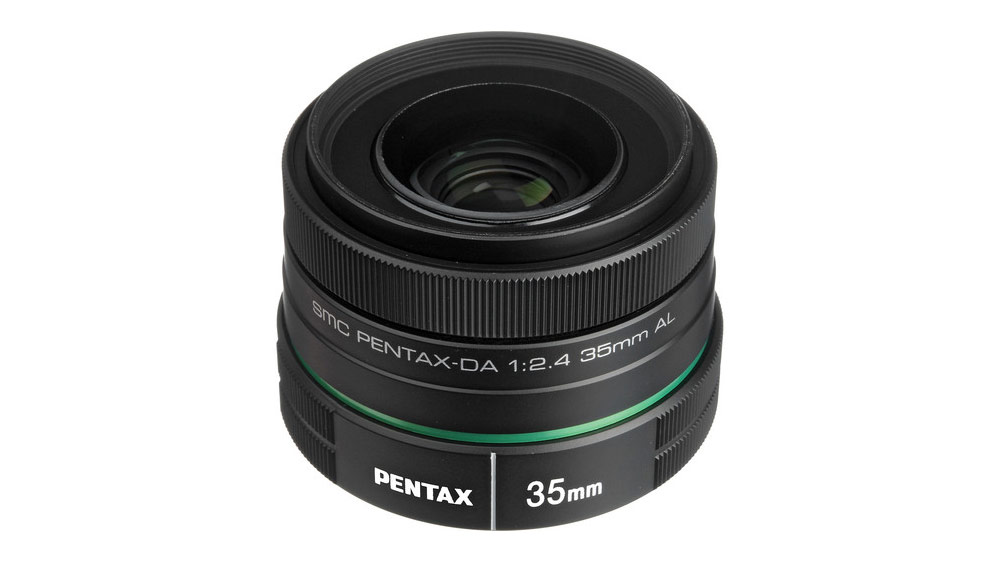
At a glance:
- Weighs 124g
- 0.3 minimum focus distance
- 53.5mm equivalent focal length
- 49mm filter diameter
- Not in production
- Price: $116 / £159
If you’d like an everyday lens that captures your point of view (as you focus your attention), then you can’t go far wrong with the smc Pentax-DA 35mm F2.4 AL. Providing an equivalent focal length of 53.5mm, this tiny lens measures a mere 45mm in length and weighs a nimble 124g, yet boasts a maximum aperture of f/2.4.
Lenses like this can enjoy a simple design yet garner decent image quality – in this case it’s a simple lens construction of 6 elements with an aspherical element to minimise aberrations. You don’t get the same build quality as Pentax * lenses, but why would you in a lens that costs less than £200? Take it out on a walk, make family snapshots and pleasing portraits, it’s a lovely lens. For the same outlay, an alternative is the smc Pentax DA 50mm F1.8 which gives an equivalent 76.5mm focal length.
Pros:
- Exceptional value for money
- Very lightweight
Cons:
- Build quality inferior to pricier lenses
Best compact Pentax lens: HD Pentax-DA 40mm F2.8 Limited
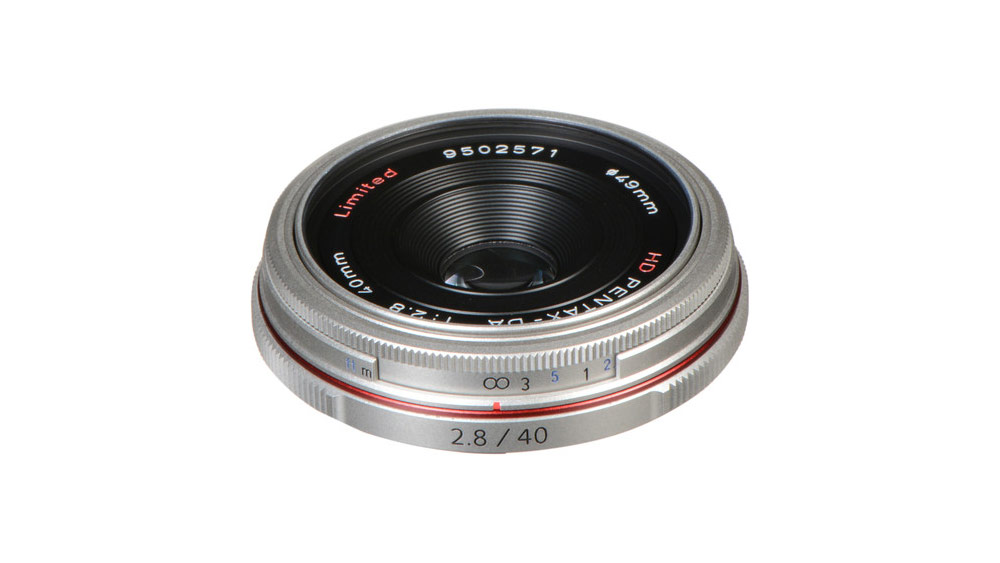
At a glance:
- Aperture range f/2.8 to f/22
- Weighs 89g and measures 15mm
- 61mm equivalent focal length
- 30.5mm or 49mm filter diameter
- Not in production
- Price: $396 / £429
If you thought the 35mm f2.4 lens was light at 124g, try the HD Pentax-DA 40mm F2.8 limited for size. It’s a ‘pancake’ lens at a feather-light 89g and only 15mm long. There’s a lighter-still ‘XS’ version at 52g and 9mm long which is described as the ‘biscuit’ lens, practically the size of a lens cap and cheaper than the Limited version featured here. Who needs a body cap when you have a pancake lens?!
Both pancake lenses offer a 61mm equivalent focal length and comprise 5 elements in 4 groups. For the extra outlay, the ‘Limited’ version has a metal build, lens hood and accepts threaded lens filters at either 49mm or a curious 30.5mm. Another fine example of an everyday lens, offering that extra quality over a smartphone camera thanks to sharp detail in the centre and more control over depth of field with that f/2.8 maximum aperture.
Pros:
- Slim and tiny
- Metal construction (on Limited version)
- Sharp centre detail
Cons:
- Can be hard to find
- Simple optical construction
Best APS-C telephoto zoom: smc Pentax-DA* 50-135mm F2.8 ED [IF] SDM
![smc Pentax-DA* 50-135mm F2.8 ED [IF] SDM lens](https://amateurphotographer.com/wp-content/uploads/sites/7/2022/08/smc-Pentax-DASTAR-50-135mm-F2.8-ED-SDM-.jpg)
At a glance:
- Aperture range f/2.8 to f/22
- Weighs 685g
- 76.5-207mm equivalent focal length
- 67mm filter diameter
- In production
- Price: $999 / £1079
Of the f/2.8 trinity of zoom lenses, the smc Pentax-DA* 50-135mm F2.8 ED [IF] SDM is the telephoto option for APS-C format cameras like the Pentax K-3 III. It’s such a versatile focal length and an ideal pairing for those earning money from photography, especially for events and sports, but also portraiture and even landscapes.
A surprisingly compact and lightweight lens with internal focusing that means the physical length of the lens is unchanged, the 50-135mm F2.8 boasts an excellent build quality and is armed with Pentax’s finest lens construction, packing 18 elements in 14 groups that included extra-low dispersion (ED) elements. It’s actually very good value, too. For those shooting full-frame with the K-1 II, the HD Pentax-D FA* 70-200mm F2.8 ED DC AW is the equivalent and appropriate choice. It may be on the more expensive side, but you’ll still get your money’s worth.
Pros:
- Compact and lightweight (considering)
- Good value
Cons:
- APS-C only
Best Pentax macro lens: Pentax-D FA 100mm F2.8 Macro WR

At a glance:
- Aperture range f/2.8 to f/32
- Weighs 340g
- 0.3m close focusing
- 49mm filter diameter
- Not in production
- Price: $546 / £509
If you’re going to get one Pentax macro lens, it has to be the Pentax-D FA 100mm F2.8 Macro WR. The classic 100mm focal length (which is 153mm on an APS-C camera) provides a decent working distance from tiny subjects while obtaining the maximum 1x reproduction ratio (1:1 life size). Machined aluminium casing, weather-resistant construction, it’s a tough lens for confidently exploring the macro world and whatever conditions it throws at you.
It’s an auto-focus lens with a focus mechanism that also provides a smooth manual focus experience with Quick-Shift focus on board – that’s good news for macro photographers who usually obtain sharp focus initially using autofocus and then tweak manually afterwards. Elsewhere, there are decent third-party alternatives for macro photographers from the likes of Laowa, including the Laowa 25mm f2.8 2.5-5x Ultra-Macro.
Pros:
- Tough and well-built
- “True” macro lens
- Useful Quick-Shift focus
Cons:
- Third-party options are cheaper
Best lens for wildlife: smc Pentax-DA* 300mm F4 ED [IF] SDM
![smc Pentax-DA* 300mm F4 ED [IF] SDM lens](https://amateurphotographer.com/wp-content/uploads/sites/7/2022/08/smc-Pentax-DASTAR-300mm-F4-ED-IF-SDM.jpg)
At a glance:
- Aperture range f/4 to f/32
- Weighs 1,070g
- 460mm equivalent focal length
- 77mm filter diameter
- In production
- Price: $929 / £1179
For telephoto wildlife photography, a smaller sensor brings several advantages, and this APS-C lens provides an equivalent 460mm focal length with f/4 maximum aperture yet only weighs around 1kg. A full-frame equivalent would be much heavier but also much more expensive. In addition, there’s a little extra depth of field that’ll improve your chances of sharp focus where you want it on far-away subjects.
Sensor format aside, the 300mm F4 lens is solid, with sealed components gaining that ‘AW’ status, plus an inner SDM focus mechanism for quiet and smooth autofocus. A close focus distance of 1.4m enables a 0.24x reproduction ratio so you can get reasonably close, too. If you don’t need as much of a telephoto reach, then the smc Pentax-DA* 200mm F2.8 ED [IF] SDM is an equally impressive lens at a similar price point.
Pros:
- Excellent weight-to-reach ratio
- Really good value for money
- Close focusing distance
Cons:
- Some autofocus unreliability
Best zoom lens for sports: HD Pentax-D FA 150-450mm F4.5-5.6 ED DC AW
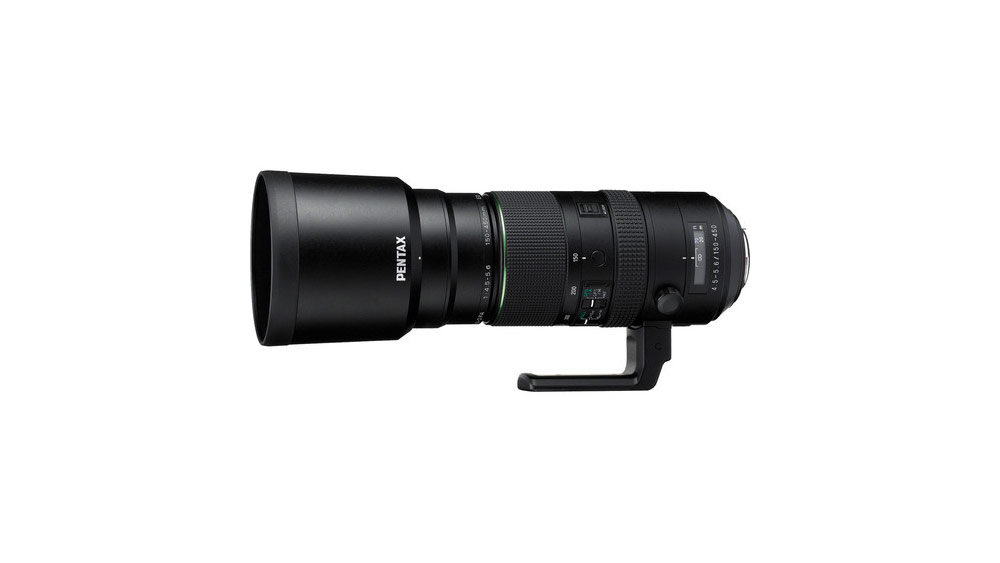
At a glance:
- Weighs 2,325mm with hood and collar
- 86mm filter diameter
- Close focusing 2m
- Not in production
- Price: $1896 / £1979
The HD Pentax-D FA 150-450mm for full-frame Pentax cameras filled a large void in the K-mount lens range when it was launched. It’s a particularly popular lens with sports photographers especially those on the sidelines who need that long reach when the action is far-away but the ability to zoom out when subjects move closer. If you opt to use an APS-C camera like the K3-III instead of a full-frame K-1 II, then the focal range is extended to a mammoth 230-690mm.
This is a lens designed to withstand what the elements throw at it, being sealed in 21 places and boasting a solid construction. At more than 2kg it’s a hefty combination when paired with Pentax flagship cameras.
K-mount lens exteriors tend to be simple, but here there are four AF buttons, a three-way switch for quick access to Quick-Shift focus modes, a focus range limiter, zoom lock, plus a rotating lens collar. Throw in HD and SP lens coatings and the premium Pentax optics and the package is complete. The most obvious alternative for APS-C cameras is the smc Pentax-DA* 60-250mm F4 ED [IF] SDM.
Pros:
- Lots of physical controls
- Solidly constructed
- Premium optical quality
Cons:
- Very weighty
Best third-party portrait lens: Laowa 105mm f/2 (T3.2) STF
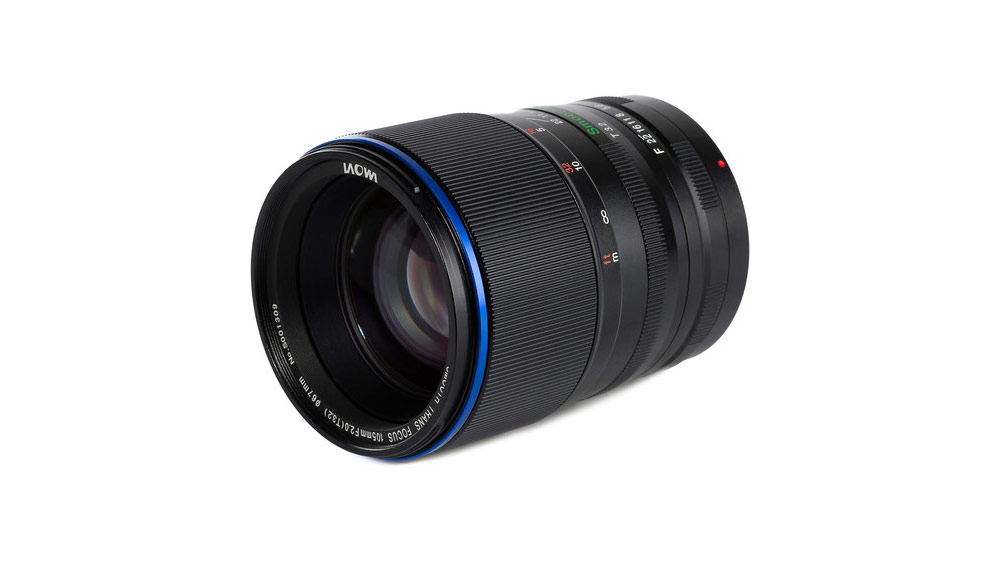
At a glance:
- Aperture range f/2.2 (T3.2) to f/32
- Weighs 745g
- Manual focus
- Two diaphragms
- 67mm filter diameter
- Price: $699 / £749
In our review of the Laowa 105mm f/2 STF lens, we waxed lyrical about the quality of blur and bokeh in this unique lens primarily designed for portraiture. Like most Laowa lenses, it’s a solid metal manual-focus only lens that stands out from the crowd, in this case featuring an apodization element for what’s called Smooth Trans Focus (STF). There’s also dual diaphragms; a de-clicked 14-blade T-stop aperture and clicked 8-blade f/stop aperture.
In short, STF creates a particularly sharp in focus area and a buttery smooth out-of-focus transition and bokeh. However, portrait photographers using a Pentax DSLR need to know just how hard it is to acquire sharp focus with this manual focus lens and no manual focus assist like you get with a mirrorless camera. It’ll sharpen your own technique as you persist and the focus ring itself handles very well, but the hit ratio of sharp shots will not match an autofocus lens.
Lens flare can be a bit of an issue too, and as an aside there’s no electronic contacts for metadata nor Laowa lens profiles for raw editing. Still, when all the elements come together the results can be spectacular.
Pros:
- Beautiful bokeh
- Satisfying manual focus experience
Cons:
- No electronics at all
Read our full review of the Laowa 105mm f/2 (T3.2) STF.
Best third-party super-zoom: Sigma 18-300mm F3.5-6.3 DC Macro OS HSM

At a glance:
- Weighs 585g
- 28-450mm equivalent focal length
- 1:3 macro capability
- 72mm filter diameter
- No longer in production
- Price: $320 / £370
If you want an all-in-one travel lens, then the Sigma 18-300mm is a solid third-party option and a sensible kit lens upgrade. The ‘DC’ badge indicates this is a lens designed for APS-C cameras and its 16.6x optical zoom covers the 28-450mm focal range (approx) when attached to a camera like the Pentax K-70. At 585g only and a fraction over 10cm in length, it’s also a well-balanced pairing with the K-70.
Not only is a wide focal range covered, but macro photographers are well catered for with a close focusing distance of 0.39m and maximum 1:3 life-size reproduction. Attach Sigma’s optional AML72-01 macro filter designed primarily for this lens and you get 1:2 life size shots.
The Pentax version of this lens does not require Optical Image Stabilisation because ‘Shake Reduction’ is provided in-camera. Sigma’s HSM autofocus motor is on board for quick-and-quiet focusing, while the lens construction of 17 elements in 13 groups includes low-dispersion glass.
When stowed away the zoom lock prevents the barrel from extending and avoid potential barrel damage. All in all, an excellent travel lens. Those that aren’t fussed about the wide-angle end here could look at the HD Pentax-DA 55-300mm f/4.5-6.3 ED PLM WR RE as an alternative.
Pros:
- Short close-focus distance
- Balances well with APS-C DSLRs
- Do-it-all focal length
Cons:
- No full-time manual-focus adjustments
Best full-frame travel lens: HD Pentax D FA 28-105mm f/3.5-5.6 ED DC WR
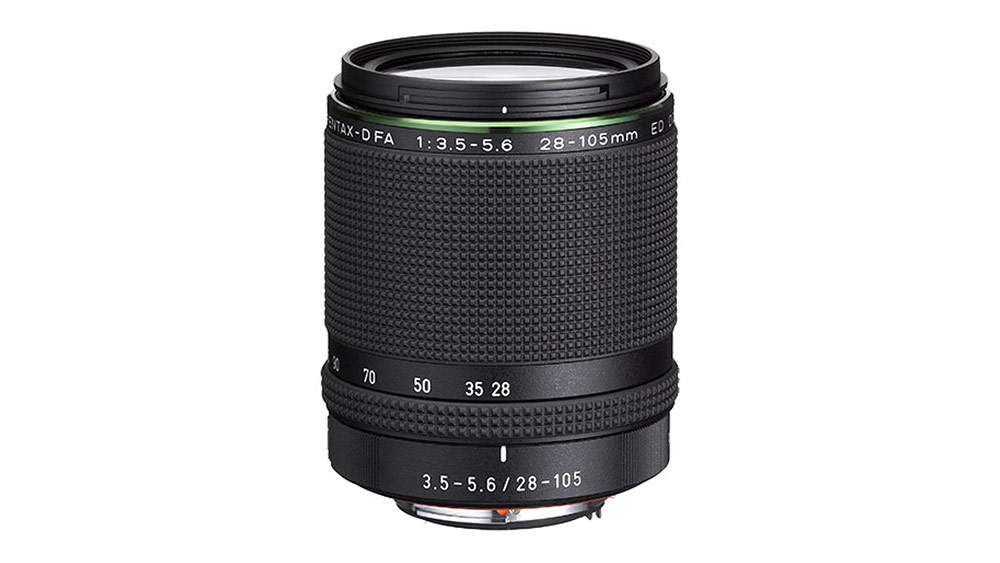
At a glance:
- Weighs 440g
- 0.22x magnification
- 62mm filter diameter
- Not in production
- Price: $496 / £569
Launched alongside the Pentax K-1 that marked the birth of Pentax’s full-frame DSLR range, the HD Pentax D FA 28-105mm f/3.5-5.6 ED DC WR is a low-cost zoom lens for K-1 or K-1 II shooters. Used on an APS-C camera and that focal range becomes 43-161mm.
It may not offer quite the same reach as the Sigma super-zoom lens, but 28-105mm is plenty enough for the majority of scenarios on your travels. It is also a well-built weather-resistant lens that weighs a mere 440g – that’s impressive stuff for a full-frame lens.
As for the design – it’s simplicity personified. There are no switches or buttons, just a large ridge zoom ring and focus ring to get to grips with. Performance-wise, autofocus is snappy and virtually silent, Quick-Shift focus features, and there’s Sigma’s HD and SP lens coating to reduce flare and protect the front lens element. This is a lens that punches above its weight.
Pros:
- Affordable for full-frame
- Tough, but lightweight
- Simple, effective design
Cons:
- Not as broad a range as the Sigma
How to choose a Pentax lens
Now, let’s take a quick look at how best to go about choosing the right Pentax lens for what you want to shoot. If you’ve browsed Pentax lenses already, you have noticed that they have a heck of a lot of letters in their names, even by lens standards. What does it all mean?
Digital-age lenses by Pentax are denoted with a ‘D‘. More specifically, ‘DA‘ or ‘DA*‘ lenses are designed primarily for APS-C format cameras while ‘D FA‘ or ‘D FA*‘ lenses are for full-frame.
Despite getting in on the DSLR action early with the APS-C format *ist D in 2003, it would take Pentax another thirteen years to create a full-frame DSLR in the shape of the K-1 in 2016. As such, there are plenty APS-C format lenses to choose from, and a more limited full-frame range.
Those with an APS-C format camera like the Pentax K-70 can use full-frame lenses with a 1.5x focal length multiplier (approx). For example, the professional Pentax-D FA* 50mm f/1.4 SDM AW lens on a Pentax K-70 becomes a 76.5mm lens.
Likewise, attach an APS-C lens to the full-frame Pentax K-1 or K1 II and it’ll work, albeit with a 1.5x crop to avoid vignetting. There’s an in-camera automatic ‘Crop Mode’ for such a set up. However, to get the most resolution out of a lens with the full-frame K-1 or K-1 II, you’ll want a full-frame lens.
In recent lenses, ‘SDM’/ ‘DC’ / ‘PLM’ / ‘IF‘ all refer to the autofocus motor. For example, ‘SDM’ denotes supersonic direct-drive motor and is responsible for the high-accuracy and autofocus speed performance.
Pentax also places a high standard on the build-quality and operability of its lenses, with ‘AW‘ or ‘WR‘ referring to all weather or weather resistance. ‘HD‘ and ‘SP‘ are lens coatings that reduce flare and protect the lens surface respectively, while ‘AL‘ and ‘ED‘ are types of lens elements designed to improve image quality.
Every Pentax DSLR made since the Pentax K100D in 2007 features sensor shift stabilisation (‘Shake Reduction’). As such, modern Pentax lenses do not need to add optical image stabilisation to the mix.
Good news is there’s a heck of a lot of Pentax lenses, covering virtually all genres of photography.
Further Reading
Best Pentax DSLRs you can buy
Best lenses for astrophotography
Best lenses for low light, from just £129
How to check a second-hand lens for faults

